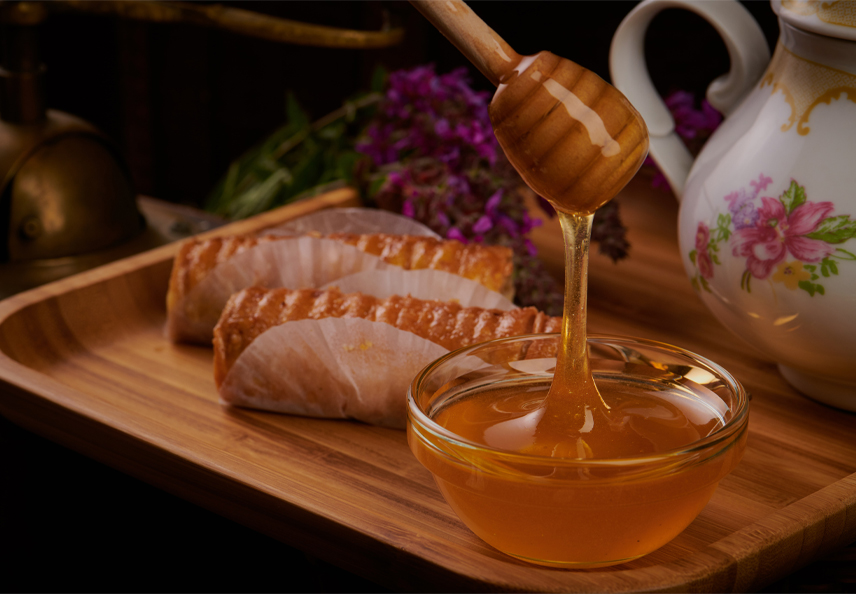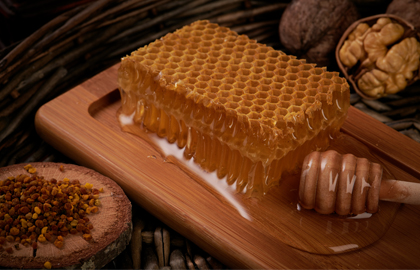
Honey and bees
►Since ancient times the climate of the Armenian Highlands has been favorable for the breeding of bees and the accumulation of honey in great abundance (Approximately 300 nectar-rich tree species and more than 600 types of wild herbs, shrubs are commonplace in the area). This fact has contributed to the decision of our ancestors to engage in beekeeping activities. The various archeological materials, historical and folk sources indeed confirm the presence of bee related agriculture in the early pages of Armenian history.
►The words honey and bee (meghr and meghu) are typical Armenian words and were originated from the word “mel” of proto-Indo-European. Honey is a sweet, viscous, thick syrup made by bees from the nectar of plants. All the sweet and tasty things are compared with honey (as sweet and tasty as honey). For instance, very sweet sorts of pear, apple, and apricot are called honey pear, honey apple, and honey apricot, in the same way, a very sweet pumpkin is called honey pumpkin. The first month of the newly married couple is called’honey month’ or ‘honeymoon.’ A mealy-mouthed person is also called honey-mouthed,to honey means to sweeten, to be in honey means to live aplenty.
►MovsesKhorenatsi calls Tigran the Great honey-eyed, writing that Tigran brought peace to the country, filling the houses with oil and honey.
►The word cluster (in Armenian “pars”) comes from the word dance (par) which means circle. Thus,clustermeansdance, acircleofbees.
►In the proto-Indo-European bees had two names “bhel” and “honey fly”. It was forbidden to mention the name of these insects in honey-gathering season that is why the name “honey fly” was invented.
►DiodorusSiculus (1st century B.C) tells that he has met many fertile areas in Armenia, abundant in fruits where honey flows richly from bushes (talking about manna). The Byzantine historian Basil of Caesarea (4th century) writes that in Armenia bees collect honey even from the dew-like manna on the bushes.
►GhazarParpetsi considered Ararat valley a gift from God, which is full of bread and wine as well as honeyed and aromatic herbs that are useful for medicine.
►Faustus of Byzantium writes that bees make honey from the manna descended on the forest of the village Hatsekats (also called Paradise of Bread) of Taron. Shirakatsi also considered Taron fertile village, land of honey, manna, and fruits. ZanobGlak in his turn considered it grassy and mellifluous.
►In the horticultural areas, beehives were often placed straight in the gardens that is why it is believedthere is no garden without apiary, there is no fruit without a bee.
►The usefulness and taste of honey depends on the flower from which the bee collects the nectar. For instance, in areas where tobacco grows, honey has a bitter taste. Honey is called “mad” if it grows in an area where many poisonous plants grow, as it causes temporary insanity. That feature of honey is still viewed in some parts of Javakhq and Gugarq. Such honey is derived from the nectar of local poisonous plants (wormwood, fern, mountain rose, aconite, white poplar, flowers of swampy bushes).
►Greek historian Xenophon (5th century B.C) indicates that Greek troops have seen a large number of beehives while passing through Armenia. Some soldiers had gone crazy by overeating honey and those who ate little, seemed to be drunk. They recovered after 3-4 days.
►Strabo (66th century BC- 24th century AD) tells that Caesar’s troops were destroyedafter eating honey. They have lost their consciousness and afterward were attacked and destroyed by locals. Pliny the Elder, Elia as well as many other travelers have written about that stunning heady honey.
►Foreign sources (11th- century Persian traveler Nasir Khusraune, 12th- century Arab geographer Yakut al Hamavin and others) witnessed that beekeeping was quite advanced in Armenia. Honey was sold and was exported in big amounts.
►HovhannesDraskhanakertsi (10th century) writes that during plunder, Arab barbarians took hives from Armenia. Moreover, honey also existed among the products given to Arabs.
►In the Middle AgesArmenians have also used venom of bee against the enemy. Castles had apiaries where the yellow colored bees were being preserved. Pannier hives filled with bees were rolled down to the enemy troops. Troops fled in panic from the bites of furious bees. For this very reason, the Mongol-Tatar hordes were destroying apiaries, not to be used against them.
►There are several rules in the medieval manuscripts concerning the beekeeping. For example, specific rules of MkhitarGosh’s (12th century) Datastanagirq (Code) were prohibiting the sale of sick hives and bee families having an old and sick mother. In the code written by David son of Alavka (12th century), rules on preserving the honey from pests and keeping it clean are written under the heading “About the mice who fell from honey.” In the Datastanagirq (Code) of Smbat the Constable (13th century), the one doing fraud during the trade of the bees should be punished. CatholicosHovhanMandakuni’s (5th century) regulations prohibited the drinking of vodka made from honey.
►Beekeeping played a big role in ecclesiastical households of Armenia.Beeswax was used for trimming the parchment, making special writing boards and candles. Church received an immense profit from the sale of candles.
►In the ancient times candle was made of beeswax.
►Burning beeswax has a germicidal and air cleaning effect.
►Beeswax was chewed for the hygiene of teeth.
►In medieval times, white candles were considered luxurious gifts and for that reason, Armenians, amongst countless other presents, gave the Persian Shah Abas some white wax. According to ArakelDavrijeci (17th century), the Shah was amazed that the creator of the white wax was Master Movses and asked him to tell the Persians his recipes. In return, the great Shah granted Movses his wish and gave freedom to the Armenian Church.
►Honey is one of the oldest foods of men, and it used to be foraged.
►Armenians always believed that honey and beeswax are holy. That is why, people used to bring honey when visiting an ill person’s house.
►Medieval Armenian doctor AsarSebastaci wrote that a doctor would never visit a house where honey was always present. Doctor Aleksianos believed that by eating three bites of crystalized honey each summer day, a person could stay healthy.
►Honey played a big role in the Armenian cuisine. After all, it is sweet, healthy, and has healing capabilities.
►Honey was often used for preparing dessert during festivals and rituals.
►As a healing meal, women who just gave birth were given omelets with honey.
►In fact, in most Armenian sweets, such as cakes, jam, and halva, honey was an important ingredient.
►During the description of Van cliffs, Turkish traveler ElviaCelebi has described the process of the creation of rechel (Armenian sweets). The well-cleaned leather of cows and buffaloes was put into honey and stored away in caves. The leather melted in honey, and great sweets were created.
►Turkish traveler Kyatib Celebi (17th century) wrote that Armenians put different layers of milk cream and honey and left them in small holding tanks. After some time, the substance turned into sweet candy.
►Honey was also used for making syrup, vodka, and vinegar. The honey syrup was used as a soft drink. It was also added to soups to produce a sour taste. Roses, basil, and other aromatic plantswere sometimes also added to syrups.
►The drink made from the honey of the Varaga Mountain was very famous for its intoxicating properties after the mixing of cinnamon and the passage of 3 days.
►Honey was considered the food of gods. According to the legends, Tir, the Armenian god of wisdom and art, had a tendency to sit atop the mountain Tirkatar, and eat the honey specifically made for him, stored in 10 jugs inside a nearby cave.
►In the epic of the Daredevils of Sassoun, the main character, David, refuses to drink the milk of IsmilKhatun. He is fedwith honey and butter instead, from his homeland Sassoun.
►In Dersim, killed snakes were put in front of beehives in May and June. During an hour, bees were bugging the meat of the snake and afterward the skeleton was left. The honey of bees fed with snake’s meat was kept separate, as a medicine for treating gastric diseases.
►There is a river in Armenian Highlands named Mexratsor (flowing honey) the name of which has a very interesting story. As the Sun rises, nearby cliffs are scorched. Due to this, all the hives located on the cliffs also get considerably warmer, resulting in the melting of honey and its eventual flow into the river. As the inhabitants of the area noticed the flow and the sweet taste of the water, they named the river Mexratsor.
►Honey, beeswax, propolis, and bee venom occupy a large place in the recipes of prescriptions for the treatment of diseases proposed in the traditional medicine, as well as in the works of the medieval Armenian physicians such as “Consolation of Fevers” of MkhitarHeratsi, “Study of the nature of man and his pain” of Grigoris, “The benefit of medicine” and “Ineligible for ignorant” of AmirdovlatAmasiatsi, “Book of art of medicine” of AsarSebastatsi, “Book about medicine” of BuniatSebastatsi.
►In medieval Armenia, honey was also used for the diagnoses of diseases. For example, the doctor Aleksianos wrote that to determine whether a liver disease is lethal or curable, a mixture of vinegar and honey should be applied over the liver. If it dries up, the liver is curable. If it stays fresh, the patient will die.
►Doctor Aleksianos was also involved in beekeeping and in his work “Vasnmeghvac,” he wrote 24 disciplinary tips regarding the practice of beekeeping. According to him, if the bees were gathered as a swarm and were hovering in the air, preparing to leave, there was one easy way to lure them back. He suggested collecting some wallflowers and holding them near the flying swarm. After some time, the bees would begin to follow the wallflowers as they have a similar scent to the queen bee.
►From ancient ages, the Armenian Highlands have been home to yellow bee, which is resistant to many pests, almost never gets ill, and recovers quickly. The yellow bee is also frost-resistant, has a very sophisticated sense of scent, and accumulates rather large amounts of honey and beeswax. In addition, it is peaceful and never steals.
►The place (tree, rock) where a beehive is located is said to be protected from lightning strikes, as bees can repel electric charges.
►When bees successfully defend against and kill invading pests (mice, snakes) they attempt to carry their dead bodies out of the hive. If this is impossible, they wrap the carcasses with wax so that it does not obstruct their actions and does not spread disease or stench.
►Bees from the same hive can recognize their mother and each other by scent.
►Instead of mothers feeding their children, in bee colonies children feed their mother, the queen. The queens are fed royal jelly, a honeybeesecretion that is created from the glands of 7-14 days old worker bees and is turned into a milk-like mixture as soon as it touches the air.
►When bees foresee their death, they leave the beehive.
►When the honey guide bird spots a beehive, it produces a unique call. When a bear hears the call, it quickly realizes that a beehive is nearby. The bear then typically follows the direction of the voice, finds the location of the hive, and starts to eat the honey. The honey guide joins the bear, and the two of them enjoy the honey.
►Loggerhead shrikes are thetype of birds, which have a unique way of killing their favorite prey. After they manage to catch a bee, they impale it on sharp objects and wait until the insect dehydrates. Afterward, they simply consume the dry body.
►Bearded reedlings, storks, bee-eater birds, and frogs also hunt down bees. Occasionally, hungry woodpeckers drill into hives and begin to eat both the bees and their honey.
►Bees tangle in the flowers of radial foxtail, because of the sharp-clawed fibers of the flower, that catch the bees.
►Queen bees can lay eggs for many years after impregnation while male bees die immediately after it.
►There are several mentions of bees and honey in Armenian manuscripts, verses of medieval poetry, folklore (fairy tales, riddles, songs, and proverbs).
►In the world beekeeping exposition opened in 1913 in Feller City, California, USA, EghisheChiftalaryan presented his aluminum, bee frame, which won the gold medal.
►In Armenia, beehives had been stumped, panniered (baskets woven from linden or willow branches), wooden and cylinder shaped.
►In ancient times, honey was kept in linden barrels or glazed clay pots.
►In 1870-1874, the magazine “Bee” (EditorHarutyunSvachyan) was being published in Constantinople. It was one of the leading periodicals of the time.
Beliefs
►Beeswax was thought to be the best protection against the evil eye and pain. Crosses made from beeswax were hanged down from the necks of frightened men. Young girls and brideswere used to apply beeswax into their aprons to scare away the evil eye. For the same reasons, beeswax was compressed into small blobs, wrapped in cloth, and attached to children’s hair or clothing.
►Beeswax was applied to the newly cut hair of 1-year-old children, and the result was attached to the main log of the house.
►To protect cows from the evil eye, beeswax was applied to either the base of their horns or the hairs of their tails.
►Scrolls have been found which contained signs thought to be enchanted. These scrolls were attached to the beehives to protect them from dark powers.
►Before the 20th century, horseshoes were attached to average beehives and snails, pieces of iron, blue beads were hanged down from woven hives. It was believed that this would somehow shield the bees from dark powers and diseases.
Myths
►In the Holy Bible it is written that when God wishes to test Job’s faith, he afflicts him with a disease. Worms begin to consume Job’s body, yet his belief is unshaken. He even helps the worms to climb upon him and tells them that they should eat him as his body has been created for them. Rumor has it that these worms are the ancestors of bees.
►In Sassoun, an ancient Anatolian province, which washome to many of the Armenian national epic’s giant strongmen, honey derived from a dragon’s body was immortal. According to the legend, if bees feed from a scaly dragon’s carcass, the honey produced will be abundant, and anyone who manages to eat even a tiny drop of it will be cured of all diseases, and live eternally.
►Bees once decide to make a deal with Solomon the Wise, king of Israel. They tell him that they can make gold for him, but in return, their bites will turn fatal. Solomon replies that he does not wish to gain gold at the expense of others’ lives. He then goes on to state that it would be far better if the bees made honey for him and died on the spot whenever they happen to bite someone. From this day on, bees refrain from reckless bites to live longer.
►When the invading Mongol hordes were burning down and destroying everything in Armenia, the letters of the manuscripts hidden deep within monasteries, turned into bees and flew away. Before the invention of the Armenian alphabet by MesropMashtots, pagan manuscripts constructed from stone, were commonplace. According to another legend, as the enemy fractured and broke these stone records, all the letters instantaneously turned into bees.
►According to rumors, after taking a swim in the clear waters of a pond at the base of Mount Grgur, Astghik, the Armenian goddess of love and maidenly beauty, lays down on the sand and sleeps. After she awakens and stands up, all the grains of sand that fall from her body turn into bees.
Prescriptions
►A drop of lukewarm honey is useful for the eye pain and reduced eyesight.
►The mixture of cherry juice and honey is very useful for the red blood cells.
►The mixture of dill water and honey can be used for the bone and joint pain.
►Flour of roasted flax, mixed with honey helps in case of a cough. The mixture of wax and honey cures wounds. The oil of flax mixed with flour and honey soothes stomachaches and is useful for lung, kidney, and intestinal diseases.
►Mixture of willow leaves and honey dries and cleans the wounds.
►Grinded dry arum mixed with honey is put on the body ulcers and wounds.
►After cleaning the aching places of body with alcohol, a cover made of the frame of the beehive,was put on them.



